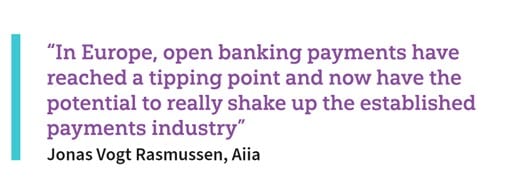The Future of Open Banking Payments
ARTICLE

Open banking payments hold the potential to deliver innovative payment solutions that meet the needs and expectations of a modern economy and changing world, yet more needs to be done for it to reach full adoption across the market.
And so, the question arises, what can be done by financial institutions to help shift customer attitudes and build consumer confidence in open banking payments? How can the Financial Services industry address the barriers that prevent open banking payments from reaching their full potential? What is the next open banking payments solution set to shake up the market? And how can financial institutions compete with other innovative solutions, such as the rise of Super Apps in the East?
MoneyLIVE spoke to five leading industry experts to examine the current position of the market and how the payments industry can collaborate to shape the future of open banking payments and reap its full potential.

Benny Johansson
Head of Payments & Accounts
Handelsbanken

Jonas Vogt Rasmussen
Head of Banking Solution Sales
Aiia

Jens Stürup
Head of Transaction Banking & Payments
Lunar

Catherine Zhou
Global Head of Ventures, Digital Innovation & Partnerships
HSBC

Samantha Emery
Payments Industry & Development Director
Lloyds Banking Group
Open Banking remains something of an enigma, with much of the general public still in the dark about not just its purpose and potential, but its very existence. One survey of global consumers, commissioned by technology platform Mambu, found more than half had never even heard of Open Banking1.
But while some consumers may draw a blank if asked to describe “Open Banking”, growing numbers of them are already using services and making payments as a result of this innovation. In fact, the banking, payments and financial management apps generated off the back of access to consumer data are providing convenience, insight and control that consumers are finding they now can’t live without.
Indeed, according to the UK’s open banking services provider2, three-quarters of those customers using personal finance management apps say it helps them keep on top of expenditure; six out of ten said it helped them keep to a budget; and 64 per cent claimed that savings apps had increased their total level of savings, providing a financial buffer – and this was the first time that nearly a quarter of those had ever saved. The research found that nine out of ten reported the services were easy to use and set up, and 83 per cent were interested in expanding their use of open banking-enabled services.
These services can add value in all areas of life, not just banking. United Utilities, for example, reports that one in two of its customers have signed up to its open banking scheme, which launched last year and uses open banking financial data as part of its income-verification tool to assess if customers qualify for an affordable tariff3.
Open-banking powered services like this are gaining traction as consumers are starting to realise the true value of their own financial data.
“We have seen quite a significant increase in our API calls and an acceleration in the number of end users in the last few quarters,” says Benny Johansson, Head of Payments and Accounts at Handelsbanken. “But most of the increases are related to account information services, rather than payments, with consumers seeing value in use cases ranging from lending and personal financial management to carbon tracking.”
In the UK, which has been at the forefront of open banking, there were 4.5 million regular users of open banking at the end of 2021 (of which almost 4 million were consumers and the rest small businesses) with one million new active users added every six months. According to the UK’s Open Banking Implementation Entity (OBIE), much of the activity has centred on information sharing, enabling customers to have better visibility of their financial footprint and helping them to make smarter decisions about what to do with their money.
But the past year has seen an acceleration in activity related to open banking payments, enabling customers to pay for services or goods directly from their bank accounts rather than using a credit or debit card. In 2021, HM Revenue & Customs (HMRC) in the UK became the first Government department in the world to allow users to make open banking payments, and as of July 2022, had collected around 2.2 million open banking payments, worth about £5.5 billion4. This payment method not only significantly reduces the risk of fraud, but also customer errors, making the payment experience smoother and saving taxpayer money.
Cumulatively, says OBIE, there were over 26.6 million open banking payments by the end of 2021, with a predicted increase of more than 500 per cent in the next 12 months5.
A tipping point
These numbers represent mere drops in the ocean compared to more traditional payment methods, with cards still dominating the UK payments landscape. But it could well be a signal of where payments are heading and the huge opportunities for merchants that increase the choices offered to consumers by adopting an open banking payments solution.

Jonas Vogt Rasmussen, Head of Banking Solution Sales at Aiia, a Mastercard company, believes open banking payments in Europe have reached “a tipping point and now have the potential to really shake up the established payments industry”.
“We are starting to see adoption at a high scale throughout Europe,” he notes. “In some European countries, we are way past early adoption and we are seeing people and businesses using open banking payments extensively, especially in the Nordics and the UK, with the other countries now starting to follow suit.”
Jens Stürup Head of Transaction Banking & Payments, Lunar echoes this, saying adoption increases every month as consumers wake up to the potential of a new and more convenient way to pay. “Customer behaviours have changed,” he said. “Whereas once people opened bank accounts with the same bank their parents and grandparents used, today we see people have not just one but two banks and additional financial apps. It’s a big change in how customers see the role of banks.”
These changing attitudes mean there has been a decoupling of banking and payments, with customers now prepared to use a wide range of payment solutions from a wide range of very different providers (some of which may not even hold a banking licence) to make their lives easier, whether that’s splitting a bill with friends, pre-paying for a coffee on the go or paying business invoices.

“Customers really do have an appetite to try different payment services as long as they can trust it to be fast, seamless and secure,” says Jens Stürup of Lunar.
As Samantha Emery, Payments Industry and Development Director, Lloyds Banking Group, points out, however, even in the most gung-ho markets, open banking payments remain on the periphery, focussed on the ‘me to me’ use case such as paying down a credit card balance.
“Retail payments from open banking are a fractional proportion of payments, around 0.2% of UK payments,” says Emery. “But we are now seeing those volumes rise, around 10 per cent month on month, as customers are growing comfortable and seeing how it’s not only convenient and easy but also reduces errors.”
To really shift the needle and harness the opportunity for growth in commerce, consumers need to be convinced that open banking payments match the ease and security of established payment methods.

“It took half a century to build confidence in cards, the most popular payment type in the UK, and today customers confidently use them to manage disputes, returns, and refunds,” says Samantha Emery of Lloyds. “There’s even protection against retailer bankruptcy, which given the economic headwinds we could be heading into will be very front of mind. Consumer confidence is key. Getting people to switch from cards means those protections and benefits will have to be very visible.”
It is not just consumer protections during the purchasing journey that need to be assured. There is also significant work to be done to allay concerns about data privacy. In one survey of global consumers, 53 per cent believed open banking to be a dangerous use of data-sharing, and while almost half of respondents claimed their banks did provide reassurance on the safety of open banking or provide information on what the numerous benefits are, with another 24% stating that, while it was explained, it could have been done in a better way6.

“Privacy means different things to different people at different times,” says Benny Johansson, Head of Payments and Accounts at Handelsbanken. “Carbon trackers, for example, are viewed as very positive by some customers to help them reduce their environmental footprint but others do not want their bank to comment on non-bank issues. This is why it’s so important to know what the customer wants and that solutions are customer-centric.”
“We need high standards for all participants,” stresses Jens Stürup of Lunar. “Otherwise, a third-party provider without good data standards undermines consumer trust in everyone else. We all need to live up to the same high standards.”
Catherine Zhou, Global Head of Ventures, Digital Innovation & Partnerships at HSBC, agrees. “We must ensure we are all well equipped to deal with third party data risks and that third parties comply with the very high level of security that people expect from banks,” she said.
Banks also need to overcome the inertia of habit, by increasing the visibility of open banking payments and nudging customers down a new payment track. Volt, the account-to-account payments gateway, has launched Transformer to encourage shoppers to switch to open banking payments at the checkout to save on debit card interchange fees. Transformer can recognise when a shopper is about to pay with a debit or credit card and sends a prompt to see if they would prefer to pay directly from their bank account instead.
Sweeping up new opportunities

There is also excitement brewing about the potential afforded by the large UK banks’ implementation of Variable Recurring Payments for moving money between a customer’s own accounts. Known as sweeping, VRPs are akin to smart direct debits and give customers increased control over their finances.
“This is the next wave of innovation,” says Catherine Zhou of HSBC. “It means better financial management capabilities for consumers, whether it’s avoiding unnecessary overdraft fees or unused subscription charges.”
There’s also the potential to set spending limits over specific time periods to help consumers self-govern their behaviour and exercise financial wellness. For banks, she added, there’s the opportunity to reduce human error and reduce costs while businesses could save billions in processing fees.
“Many organisations, including us, will look at how sweeping can be used within customer journeys to really improve the customer experience through better financial management and self service,” says Samantha Emery of Lloyds Banking Group. “The industry is already starting to look beyond pure mandated sweeping so there will be competition with direct debits and card payments for e-commerce and subscriptions.”
There are challenges ahead, not least the commercial framework that sits around VRPs. “The need to contract bilaterally on specifics but to also build out at scale, sit in stark opposition to one another,” notes Emery. “To really hit scale, there will need to be some standardisation whilst leaving the commercial terms to the firms participating to develop on a competitive basis.”
Despite these potential road bumps, it’s hard to understate the potential of non-sweeping VRPs given the growth of subscription services streaming content to billions of consumers around the world. Some of these firms will be keen to explore innovative payment options to handle these large subscriber bases. Netflix, for example, is forecast to have 86 million subscribers in Europe alone by 2026, making over a billion payments a year for its services.
From SuperApps to super regulators
Some jurisdictions, of course, have been deploying innovative payment solutions for some years. In eastern markets, the SuperApp dominates much of life, from banking to payments to health care to food delivery.
Yet many experts think the SuperApp will not translate well into the more mature markets of Europe and North America. “In the more mature markets, existing methods, such as cards, were already working well. China went from zero to 100 but here we were already at 20 so the urge was not so strong,” says Zhou.
And the domination of the superapp even its own market, may come under pressure from regulators. “Rules around data sharing are only growing in rigour around the world, and that includes China, which will put pressure on the superapps,” notes Zhou.
Regulation is front of mind for all players in the fast-evolving payments market. It was regulatory action that drove open banking in the UK and Europe, and is now playing a decisive role in Hong Kong and Australia, with the latter country opening up data to sectors beyond finance, including energy and telecommunications. This raises the prospect of a cross-industry data sharing ecosystem, supercharging innovation on behalf of the customer and giving customers more control over their data, their finances and their lives.
“There are 58 countries with open banking initiatives and this creates challenges for market participation,” says Catherine Zhou of HSBC. “From agreeing on policy to compliance across multiple countries to the risk for confusion and increased costs because of policy differences across different countries, there’s a need for standardisation.”
Market players are already looking ahead to PSD3, the next evolution of PSD2, which is likely to spur further innovation in payments, lending, insurance and more. It is expected to make payments faster and safer while aligning better with the EU’s legal framework, creating a platform for not just open banking, but open finance.
A future of change, challenge and consumer convenience
Looking ahead, it’s clear the future of payments will continue to evolve, with this newly data-rich world creating new opportunities for customers and businesses. Embedded finance, for example, where payments are pushed into the background of the customer experience, will capture more of the customer wallet as they embrace a step change in convenience, accessing the funds they want when they most want them: at point of sale.

“When it comes to open banking and many other types of payments, it needs to be embedded and contextual to enable that extra level of convenience and choice for people,” says Jonas Vogt Rasmussen, Head of Banking Solution Sales at Aiia, a Mastercard company. “Convenience is at the top of people’s wish list and that’s what open banking payments fulfil. The payments are in the background so people can focus on the experience, whatever it is they are doing.”

Catherine Zhou of HSBC agrees. “Open banking payments are not just quick, they’re instant – and once you’ve experienced that you can never go back,” she says. “Open banking has shaken up the traditional financial institutions for better. They need to respond and embrace this challenge because it really can be a win-win for everyone.”
Footnotes
1https://mambu.com/insights/press/mambu-research-reveals-global-consumers-are-hesitant-to-use-open-banking
2https://www.openbanking.org.uk/news/obie-publishes-second-open-banking-impact-report/
3https://utilityweek.co.uk/open-banking-rolled-out-to-50-of-uu-customers/?utm_campaign=Daily%20News&utm_medium=email&_hsmi=213938737&_hsenc=p2ANqtz-8uybZ32EIpWp5rwGcrrUlk9xOmMgLNW1WJNiECigJ0x2_uVYlgh6HALgrw7bjWVOfy5RcOyfiygrHZnIMvK4zUn-f5C7FCx1MfuL5GtJQrieAaDt0&utm_content=213938737&utm_source=hs_email
4https://www.openbankingexpo.com/insights/qa-hmrcs-nick-down-on-winning-the-open-banking-expo-pioneer-award/
5https://www.openbanking.org.uk/news/uk-open-banking-marks-fourth-year-milestone-with-over-4-million-users/
6https://mambu.com/insights/press/mambu-research-reveals-global-consumers-are-hesitant-to-use-open-banking

MoneyLIVE is your one-stop shop for all the latest banking and financial services content from across the world. With a huge portfolio of conferences, webinars, executive roundtables and reports to choose from, MoneyLIVE provides our community with relevant and future-facing information.
Visit the website: https://moneylive-insights.com/

Aiia is the most experienced open banking platform in Europe, with more than a decade of experience in fintech and hundreds of clients servicing both businesses and consumers with open banking empowered services. Based in Denmark, the company’s mission has always been to empower people to bring their financial data into play safely and transparently. Aiia’s platform allows businesses and financial institutions to integrate financial data and to offer account-to-account payments directly in their services to an estimated reach of 337 million European citizens.
Today, Aiia has more than 2,700 connected banks across Europe, processes more than 10 million bank logins and more than a million account-to-account payments every month for large banks and e-commerce payment gateways.
The open banking platform has received backing from Danske Bank and DNB to build a leading pan-European open banking infrastructure to support financial innovation in the rapidly changing financial services industry. Aiia provides open banking services to a long list of financial institutions, including Lunar, Danske Bank, Santander, OP Financial Group, DNB, Resurs Bank, BEC, Bankdata and Pleo and won the award for Best Mobile Payment Solution at Finovate Awards in 2020 for it’s immense work on open banking payments with multiple clients.
Learn more: www.aiia.eu
Stay in the loop with MoneyLIVE
Subscribe to our newsletter to receive news, insights and special offers.